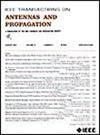用于终端带外解耦的高选择性紧凑型宽带横滤波反f天线
IF 4.6
1区 计算机科学
Q1 ENGINEERING, ELECTRICAL & ELECTRONIC
引用次数: 0
摘要
本文介绍了一种不使用任何额外馈电网络的新型宽带横滤波反f天线结构。所提出的天线结构可以在整个波束宽度的工作频带两侧产生真正的效率零(EZs),而不受轴向的限制。滤波天线包括三个耦合辐射体。被驱动的反f型辐射元件直接从端口激励,其他两个寄生辐射元件通过与被驱动辐射元件的电磁耦合激励。通过控制谐振频率和耦合关系,实现了具有三阶滤波响应的四分之一波长辐射体横向滤波天线(TFA)。该天线在其通带的每一侧都有一个EZ,显著提高了其选择性,从而能够抑制带外信号的干扰。给出了该滤波天线的设计方法。提供了一些设计指南。在不增加天线占用空间的情况下,本文所介绍的技术不仅有助于提高选择性,而且对传统非平衡天线的带宽增强也非常有用。为了验证该技术,设计、制造和测量了5G新无线电(NR)频段的天线。实验结果与仿真结果吻合较好。为了评估对带外干扰的抑制效果,构建并测试了双天线系统,其中一根天线工作在NR频段(3.3-5 GHz, 42%),另一根天线工作在Wi-Fi频段(5.15-7.125 GHz, 32%)。测试结果表明,在近阻带内,带外去耦达到20db,显示出空间有限的终端应用前景。本文章由计算机程序翻译,如有差异,请以英文原文为准。
High-Selectivity Compact Wideband Transversal Filtering Inverted-F Antennas for Out-of-Band Decoupling in Terminal Applications
This article introduces a novel wideband transversal filtering inverted-F antenna (IFA) structure without using any extra feeding network. The proposed antenna structure can produce true efficiency zeros (EZs) at both sides of the operating band across the beamwidth, not restricted to the boresight. The filtering antenna comprises three coupled radiators. The driven inverted-F radiating element is directly excited from the port, while the other two parasitic radiators are excited through electromagnetic coupling with the driven radiator. By controlling the resonant frequencies and the coupling relationships, a transversal filtering antenna (TFA) with a third-order filtering response is realized with all quarter-wavelength radiators. The antenna exhibits an EZ on each side of its passband, significantly enhancing its selectivity and thereby enabling the suppression of interference from out-of-band signals. The design method of the proposed filtering antenna is presented. Some design guidelines are provided. Without increasing the antenna footprint, the techniques introduced in this work are not only helpful for improving selectivity but also very useful for bandwidth enhancement of conventional unbalanced antennas. To validate this technology, an antenna for the 5G new-radio (NR) frequency band is designed, fabricated, and measured. The experimental results align very well with the simulations. To evaluate the out-of-band interference suppression, a dual-antenna system was constructed and tested, with one antenna operating at the NR band (3.3–5 GHz, 42%) and the other antenna operating at the Wi-Fi band (5.15–7.125 GHz, 32%). Test results demonstrate excellent out-of-band decoupling up to 20 dB within the near stopband, showing promises for space-limited terminal applications.
求助全文
通过发布文献求助,成功后即可免费获取论文全文。
去求助
来源期刊
CiteScore
10.40
自引率
28.10%
发文量
968
审稿时长
4.7 months
期刊介绍:
IEEE Transactions on Antennas and Propagation includes theoretical and experimental advances in antennas, including design and development, and in the propagation of electromagnetic waves, including scattering, diffraction, and interaction with continuous media; and applications pertaining to antennas and propagation, such as remote sensing, applied optics, and millimeter and submillimeter wave techniques

 求助内容:
求助内容: 应助结果提醒方式:
应助结果提醒方式:


